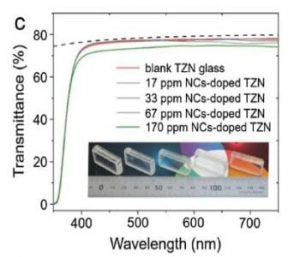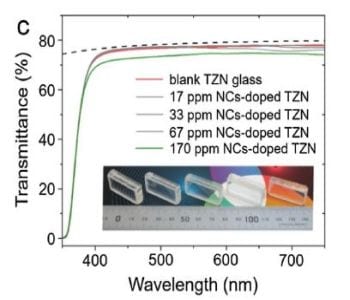A new generation of upconversion nanocrystals (UPNCs) has fueled strong interest for various applications, such as biological sensing, biomedical imaging, anti-counterfeiting, solar energy management, and 3D volumetric displays. In addition to their bio/nano-photonics applications, there has been growing interest in integrating these NCs within a photonic platform to harness the unique nanoscale properties for new hybrid glass and light-based devices.
 To date, the method used almost exclusively to integrate UPNCs in glass is the so-called glass ceramics method, which relies on the in situ growth of NCs in a glass matrix. In this method, the glass containing precursor ions is heated above the glass transition temperature to facilitate diffusion of ions inside the glass, which then form crystal seeds that grow into NCs. While the conventional glass ceramics method has seen remarkable progress in embedding UPNCs in glass, it remains challenging to attain a high level of compositional and nanostructural control of the NCs.
To date, the method used almost exclusively to integrate UPNCs in glass is the so-called glass ceramics method, which relies on the in situ growth of NCs in a glass matrix. In this method, the glass containing precursor ions is heated above the glass transition temperature to facilitate diffusion of ions inside the glass, which then form crystal seeds that grow into NCs. While the conventional glass ceramics method has seen remarkable progress in embedding UPNCs in glass, it remains challenging to attain a high level of compositional and nanostructural control of the NCs.
In a new study led by the University of Adelaide in Australia, researchers have developed a versatile direct-doping approach to integrate UPNCs in glass. To pursue high levels of compositional and nanostructural control, the researchers synthesized the UPNCs and glass separately, and then integrated them to create a highly-controllable hybrid material. The key to their success lies in manipulating the doping temperature and the dwell time of NCs in the glass melt to produce the right conditions for the survival and dispersal of the UPNCs in the glass.
Dr. Zhao and Prof. Ebendorff-Heidepriem, from the University of Adelaide, with collaborators from Macquarie University and the University of Melbourne, discovered that the upconversion emissions of erbium ions can be used to diagnose the survival and dissolution fraction of doped UPNCs in glass. To track these UPNCs across the glass, they utilized upconversion scanning confocal microscopy to visualize their 3D dispersion in the glass. They found that both optical methods not only directly provide an insight into the photonic performance of the hybrid material, but also for the first time offer ways of monitoring low concentration UPNCs in the glass over a larger scale, which is impossible using electron microscopy in this case. The researchers showed the UPNCs-doped glass retains high optical transmittance, which is very close to the quality of un-doped glass. The fibers drawn from the hybrid glass still exhibit high optical transmittance and characteristic upconversion features of the UPNCs.
The theoretical simulations in the paper furnish practical guidelines to prepare nanoparticles-doped highly transparent glass and optical fiber. Dr. Zhao and Prof. Ebendorff-Heidepriem propose that further prevention of the dissolution and improvement of the dispersal of doped NCs may be achieved through using core-shell UPNCs, where an additional layer of material around keeps them intact.
This work opens up exciting opportunities for new hybrid glass materials and multifunctional fiber devices by integrating and tailoring the unique properties of nanocrystals. The researchers believe the direct-doping approach can be generalized to other nanoparticles with interesting photonic, electronic and magnetic properties.

















